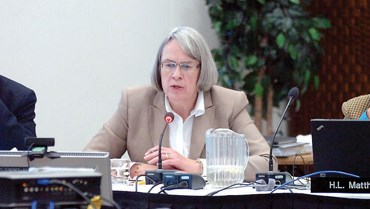Who needs to know what about the proposed Northern Gateway pipeline and when do they need to know it?
It's the big picture that's been hovering over the National Energy Board (NEB) hearings into the environmental assessment for the $6.5 billion project since the scene shifted to Prince George on Oct. 9. While the questions inside the room have often been chock full of jargon and technical issues, the broader questions about how the Joint Review Panel (JRP) process operates has dominated the public discussion.
Enbridge, the company looking for permission to build a heavy oil pipeline from Alberta's oil sands to the port of Kitimat and open Canadian crude to the Asian market, has presented reams of data related to the project and has sworn witnesses ready to answer questions. The company proudly points to thousands of documents and has said it's gone above and beyond the requirements for this phase of the proceedings.
The government of B.C., both through the questioning from its legal team and public comments by Environment Minister Terry Lake, has been among the most critical of the company's approach to the hearings so far. The provincial government insists that despite the volume of information on file and the hours of questioning from its lawyers and representatives from other interveners there's simply not enough detail on the record to know if the project is safe enough to move forward.
Ultimately it will be up to Sheila Leggett, Hans Matthews and Kenneth Bateman - the three members of the JRP - to rule if enough information has been presented for the project to move forward. Their final decision is expected by the end of 2013.
In the meantime both Enbridge and pipeline opponents will continue to make their case in an effort to win over the court of public opinion.
Environmental law professor Meinhard Doelle said it's common for companies like Enbridge to work through their final design plans after the environmental assessment is complete, but cautioned the proponent must provide enough information on the different options being considered so panel members can make an informed decision.
"You need to recognize as a starting point that an [environmental assessment] is supposed to be a planning tool," said Doelle, who teaches at Dalhousie University in Halifax. "You really want to start the process at a point where there's still an openness to consider changes to the project."
Doelle has sat as a panel member on the JRP for the Lower Churchill hydro-electric project in Labrador in 2009, helped draft federal environmental assessment legislation and has represented clients at hearings over the past two decades. He said well-run hearings need to examine the purpose of the project as well as possible alternatives, which means there must be flexibility built into the process.
"That comes at the price of not always being able to nail down all of the details," he said.
Some of the details the province and Enbridge have squabbled over is the final route selection and exactly how the company would respond to a spill in sensitive areas along the proposed route. Even if the company's plans aren't final it must be open suggestions, according to Doelle.
"The proponent not having a preferred option at this point is not a problem," he said. "But the proponent saying 'we don't want you to tell us what route to choose, that is a problem.'"
Nikki Skuce, the senior energy campaigner for environmental group ForestEthics Advocacy, attended some of the hearings in person and followed others online. She said the idea of giving interveners the chance to ask pointed questions is great in theory, but it's effectiveness is dependent on the answers from the company.
"It's a valuable platform for cross-examining but also a frustrating process in the sense that we get very few adequate answers out of Enbridge," she said. "They focus on quantity, the fact they've submitted thousands of pages but the quality sucks."
Skuce said there are gaps in the application and had hoped for better answers on topics like routing, avalanche risk and oil spill response.
"You'd think there'd be more through answers," she said. "The number of things that they haven't been able to answer, I've found surprising."
Enbridge witnesses have said the details interveners like the province and ForestEthics have been seeking will come out later in the process, if the JRP gives the project a green light to proceed. After the environmental assessment is complete the company must still meet regulatory standards imposed by the NEB.
However lawyers from the province have pointed out that interveners won't be able to ask questions at that point and that it will solely be up to the NEB to evaluate the merits of Northern Gateway's commitments.
Doelle said the JRP members must sort through the information now to determine what they need to know before making their final recommendations and what can wait for the regulatory process down the road.
"The test that I would apply would be whether it makes a difference in terms of what I will recommend as a panel member to the government," he said.



